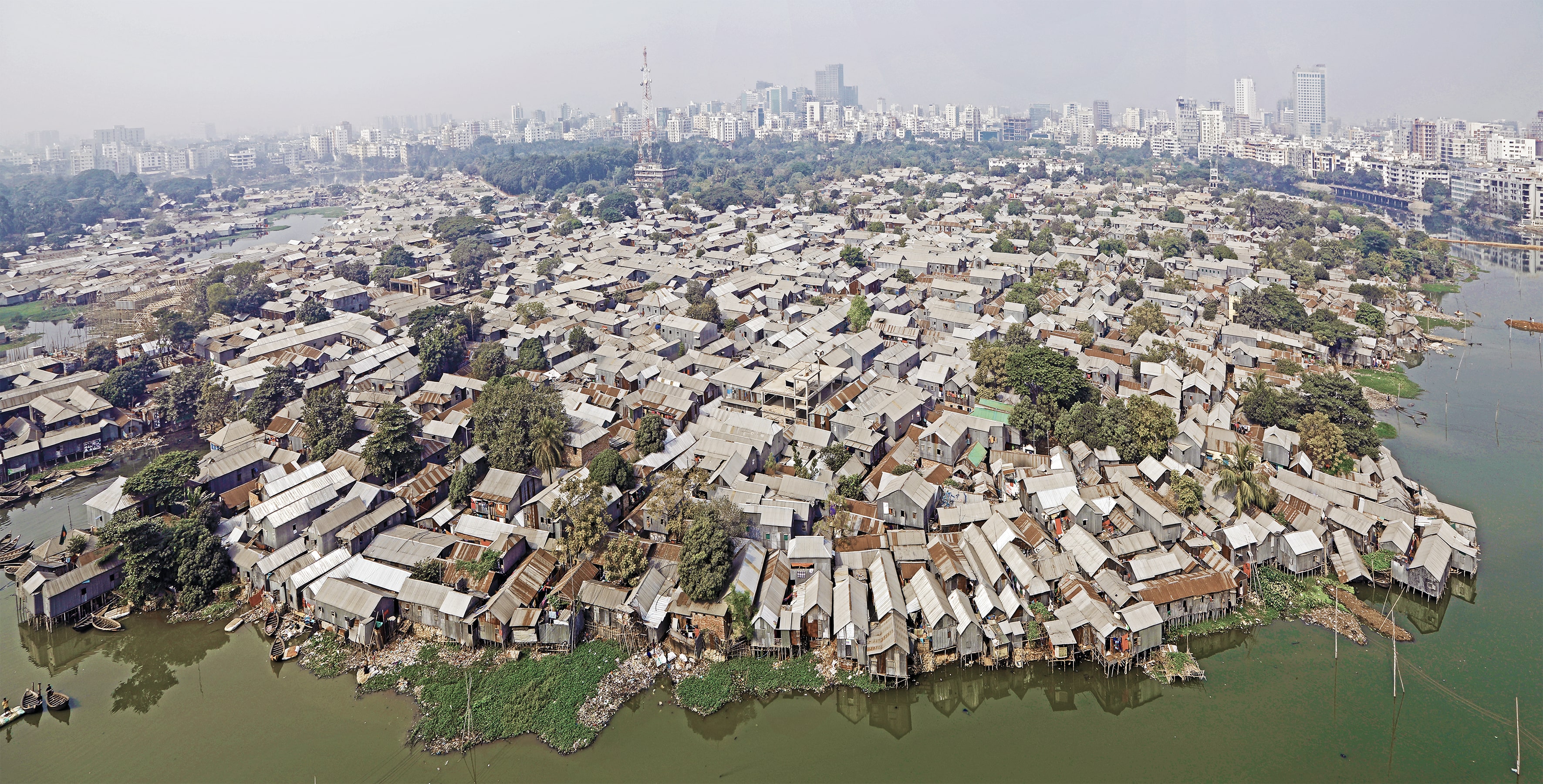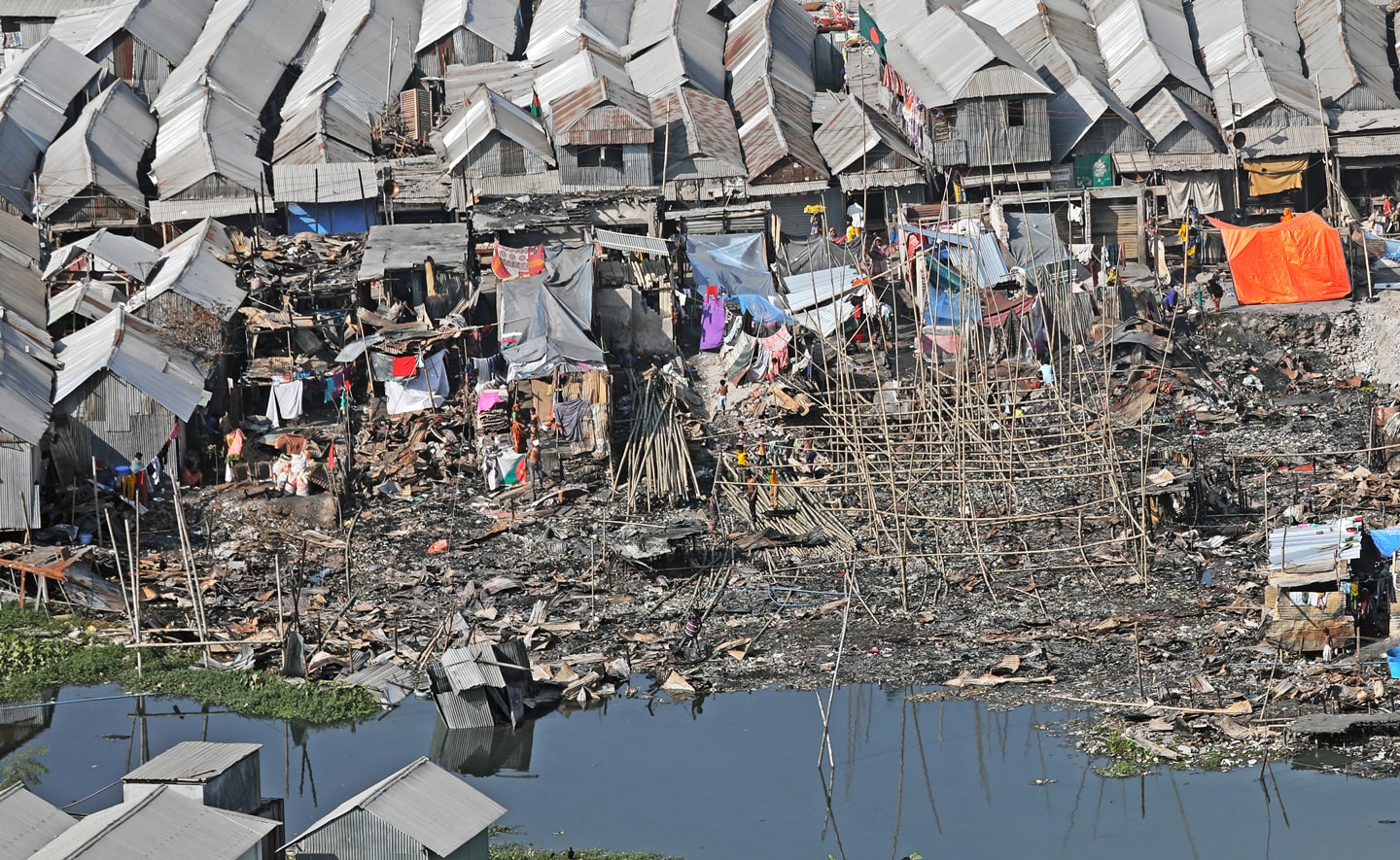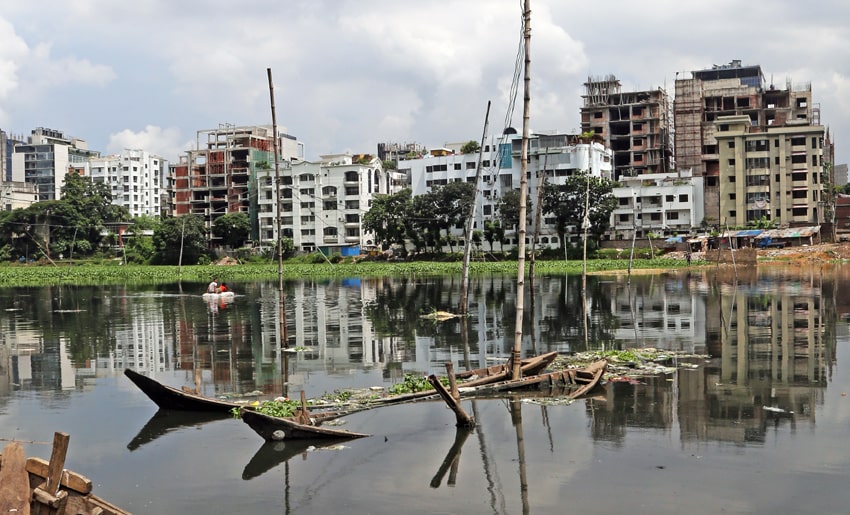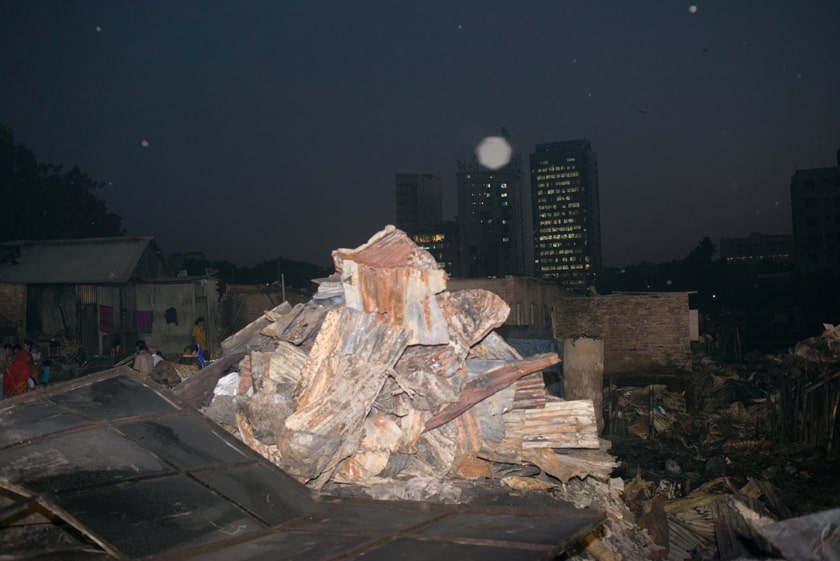
Günter Nest 2016
Creolized Technologies of Demoralization
While creolized technologies could be understood as reasserting the “human” in the technosphere, theorist and urbanist Elisa T. Bertuzzo argues that it is not necessarily humane. In parsing out the precarious and often informal archipelago-like social spaces in the Karail Basti neighborhood of Dhaka, she depicts the techniques of relation that emerge between residents, state actors, the economy, and natural degradation.
Creolizations and the discourse on the technosphere: A rencontre with losses
About the notion of creolizations (preferably in plural), I like above all the ambiguity. Ambiguity that emanates from the processes the term describes, since if as Édouard Glissant put it, “métissage is determinism and creolization, in relation to métissage, is the producer of what is unpredictable,”Compare Édouard Glissant, Introduction à une Poétique du Divers. Paris: Editions Gallimard, 1996, p. 89 (my translation). In Poetics of Relation (1996), Glissant explained: “[creolization] is not merely […] a métissage, but a new and original dimension allowing each person to be there and elsewhere, rooted and open, lost in the mountains and free beneath the sea, in harmony and in errantry […] Creolization diffracts, whereas certain forms of métissage can concentrate one more time […] Its most obvious symbol is in the Creole language, whose genius consists in always being open, that is, perhaps, never becoming fixed except according to systems of variables that we have to imagine as much as define. […] [T]he explosion of cultures does not mean they are scattered or mutually diluted. It is the violent sign of their consensual, not imposed, sharing.” See Glissant, Poetics of Relation, trans Betsy Wing. Ann Arbor, MI: University of Michigan Press, 1997, p. 34. creolization processes cannot but engender sorts of action and of thought whose premises and modes elude classification. This much is certain: “creolization” isn’t reduced to cosmopolitanism or hybridization and doesn’t describe merely cultural appropriation – not even in the emancipatory sense once given to the term by anti-colonial authors.For example, Oswald de Andrade, “Manifesto Antropófago,” Revista de Antropofagia, vol. 1, no. 1 (1928); trans. Leslie Bary, “Cannibal Manifesto,” 1991. Rather, at least going by Glissant, creolizations occur when the modes of naming, thus also thinking, both material and abstract “things” of our world become plural and this plurality creates echoes. Echoes, not cacophony, since in the expanded social space of creolized cultures and practices, respective traditions diffract in time instead of harshly overlapping each other, whereby the minuscule gap that separates emission and diffraction is filled with possibility. Accordingly, one way to conceive of creolizations is in terms of ongoing replacements of old “techniques of the absolute” through “techniques of relation” that bring forth an archipelago-like thought and social space.In the words of Glissant, Poetics of Relation, pp. 89 and 95 respectively: since “[w]e are not prompted solely by the defining of our identities but by their relation to everything possible as well – the mutual mutations generated by this interplay of relations” ‒ “[t]echniques of relation are gradually substituted for techniques of the absolute, which frequently were techniques of self-absolution. The arts of expanse relate (dilate) the arts of depth . . .”
Let’s now suppose that these techniques, operationalized in everyday practice, took the form of creolized technologies: what would the “additional possibility” imported by creolized technologies in the technosphere be? It seems to me that like every transfer, that of the concept of creolization from the field of linguistic and literary studies to the debate around the impact of technological progress on our “-sphere” and future, brings some friction and some loss with itself. Friction arises from the concept per se: shouldn’t technologies – devices and instruments programmed (literally and not) in order to fix, ease, and control production‒consumption‒reproduction – be totally resistant to creolization? On closer examination, it stands out that technologies are no less ambiguous than merely the delineated processes of creolization. Aside from the fact that their impact on our ways of thinking, though it might be well connoted by the archipelago metaphor, is to date unclear, also their practical implications are difficult to predict. Part of the reason is that their users, makers, agents are increasingly dispersed, variously entrenched, and progressively empowered, in a center-less scenario that indeed reminds of the creolization contexts.
Here, the pertinence of the issue for an investigation of the “technosphere” stands out. If the latter is conceptualized as the cumulative interweaving of technologies and natural environments, creolized technologies could be regarded as technologies, which reassert “the human” in the technosphere, and make its already complex relations even more unpredictable, importing in it a whole lot of additional possibility. Note that in this definition, I subsume creolized cultures and practices under the “human” without any idealization. Dominant representations and modes of production forge and constrain everything human: cultures and practices, creolized or not.
So, while creolized technologies interfere in unexpected ways with other technologies and natural environments, that is, with the technosphere itself that merges them, the “human” interference should not pass for necessarily humane.
Creolized technologies can serve individuals and collectives entertaining dynamic relations in social space, but are as well at the disposal of regimes of power pursuing a limitation of these same dynamics.
In other words, the “techniques of relation” that facilitating the encounter of various traditions, create intervals of unpredictability‒possibility, don’t operate in a power-less space and no one should expect creolizations to protect a technologically dominated planetary system, even the emergent archipelago-like social space, from conflict. This is the reason for which, above, I suggested that the adaptation of the literary theory of creolization to an analysis of the technosphere might imply some loss: the discourse, based as it is on the supposition of a consensual sharing, doesn’t take due account of the high probability of conflict, especially in and among collectives, and the potential risk represented by decidedly not pro-people “creolized state technologies.”

large
align-left
align-right
delete
On ephemeral collectives bringing up creolized technologies
What do creolized technologies reveal about the technosphere? My tentative answers, here, draw on observations of everyday-life practices adopted by the inhabitants of a neighborhood of Bangladesh’s capital city, Dhaka, and of recent measures taken by the state with regard to the same. When I call Karail Basti “neighborhood," I do so in an act of resistance against its far more common designation, “slum” – a designation imposed from the outside and from the top, i.e. via the English-speaking circles of international development cooperation and their innumerable “slum upgrading” programs. The inhabitants, on their part, have always spoken of basti, which in Bengali means settlement, simple as that.
The competing names mirror deeper conflicts around rather nasty issues, such as the allocation of urban “prime land” for developers’ and politicians’ dreams of a “smart,” obviously slum-free capital city fitting the needs of twenty-first century life; the fact that the area, 400 × 500 meters of publicly owned land, is declared to be illegally encroached; and sure enough, class conflicts too: those who have built Karail literally from scratch are the poor. In particular, since the early 1990s this basti has become the home of nearly 120,000 people between urban poor evicted from other settlements or displaced in the aftermath of development projects, and rural poor escaped from natural disasters or sheer poverty in the countryside.
Today, it is hard to imagine that until thirty years ago, Karail wasn’t but a swampy plot of land surrounded by the dead branches of a former canal and that its only occupants were scattered seasonal workers. Only with the stories of the earliest residents in mind can one read its multilayered space. Then, the grid of partly paved roads, contrasting with the labyrinth of tiny and invariably unsealed lanes to the north, hints at a fire, perhaps at a particularly severe flood, after which NGOs straightened the roads to create sort-of escape routes. Then, the whistling at night can’t be mistaken for playful signals of teenagers any longer, but speaks about the threat of robbery and neighbors organized against it. Then, the well-assorted vegetable market and the thousands of workshops, scrap recycling posts, eateries, cloth and garments shops, as well as the many cycle-rickshaw garages, tell the success stories of individuals who, hardly literate, managed to start thriving enterprises with the help of microcredit. With my ten years of relationships and stays, I can all the same claim I have been witness of one very important success story. Until 2013‒14, water used to reach Karail from the middle- and upper-middle-class apartment buildings of the surroundings via black pipes, which crossed the lake to the east and the boundary roads of Beltala and T&T to the west and north; for around fifteen minutes a day, every cluster – each à seven to fifteen or even twenty rooms ‒ i.e. households – would tap from one of these pipes the daily requirement of water and store it in buckets. The hardships of those days now belong to the past, thanks to the community-based leaders, or CBOs, who helped by an NGO, joined hands with CBOs from other bastis and advocated seven long years for a right to water.

large
align-left
align-right
delete
The provision of electricity, on the contrary, continues to be ensured via a “tap system,” whereby the self-organized, or creolized, supply chain means that those selling the facilities have a certain amount of maintenance work for which the end users bear the costs. Also the legalized water-management system contemplates creolized elements: instead of engineers from the water authority or public works department, the CBOs were acknowledged to be the most qualified to look after the needful construction works; to obviate the absence of registered addresses, a paperless payment system reliant on mobile phones has come into being.
In the two latter instances, the implementation of creolized technologies relies on the capability to establish novel relations outside of Karail, since the owners or managers of “legal” houses in the surroundings as well as the local employees of respective suppliers must be addressed, convinced and at times, bribed.Concerning the relations with NGOs, the high professionalization and standardization of development cooperation makes it difficult to define the adopted approaches as “novel,” but it seems accurate to say that the intervention of NGOs fosters and requires “novel” relations insofar as it always reacts to specific local circumstances and actors. Which relations do govern everyday life inside the basti? The examples provided above seem to substantiate my working definition of creolized technologies. Karail’s gross population, arrived from elsewhere in the capital city, are “peripheral” in the eyes of the elites (often, unfortunately, in their own eyes as well). The technologies they had to devise in order to survive in the basti oppose to the homogenizing city very peculiar modes of action, based on unpredictable relations and making the impossible – whether the provision of basic services or the largely peaceful coexistence of thousands under circumstances of extreme population density – possible. The effect is that Karail’s social space, in lived experience, is not “peripheral” but truly archipelagic.
Let me repeat that these relations are “human,” and not automatically humane. Firstly, there’s less collective deliberation than tactics, sagacity, and power at play when cannier, wealthier, and/or politically backed residents organize water and electricity networks, monopolize the scarce public areas, or grab their neighbors’ land to build bigger compounds and exact rents.I described the mass production of housing more specifically in Elisa Bertuzzo, “On the Myth of Informal Urbanisation: Karail Basti, Dhaka,” in ARCH+ 223 (2016), pp. 110‒17. Secondly, with the sheer numbers undermining the scope for direct representation, Karail’s cannot be defined a community – at least not in Tönnies’ understanding of homogeneous groups whose members have personal ties. Also in this regard, the choice of “neighborhood,” conveying the spatial proximity characteristic if not essential to most of the basti’s technologies, makes sense: it doesn’t promise grassroots democracy, but hints at the constant necessity to overcome conflicts in creative, if uncertain, instances of encounter.
When state technologies become creolized

large
align-left
align-right
delete
Throughout the past decades, the state has negated Karail’s inhabitants a right to stay and blatantly ignored their existence: so much so that in the official maps of Dhaka, the area is represented as vacant. On the other hand, it neglected to fund affordable housing in the growing city and left the delivery of delimited basic infrastructures, from schools to health services to microcredit, to the NGOs. Most recently, plans to build an IT-village on the site made their appearance in conferences as well as the Bengali and English-speaking media; more or less in parallel, representatives of urban and state government, city corporation, as well as political parties started to deploy the argument of “climate resilience” against the “environmentally vulnerable” settlement. Certainly, this could help lend legitimacy to an eviction. In such case, however, the authorities would have to abide by international laws, which foresee compensation and/or rehabilitation i.e. resettlement on alternative land, and given the number of people affected, this would require remarkable financial and institutional engagement.Bangladesh lacks, to date, a national law regulating the modalities of eviction, rehabilitation, and resettlement of the poor. Moreover, Karail’s most radical groups are determined to stay put in the neighborhood – which they regard as the outcome of long-term individual as well as collective struggles – and have demanded a full transfer of the ownership titles. Thereby, they can count on city- and countrywide coalitions as well as on their basti’s meanwhile global fame, ensured through scientific and media exposure.
To respond to such, unexpected, resistance corroborated by novel relations, one needs similarly novel techniques and in fact, in the last six months the state has come up with its own creolized technologies of intimidation.
For one, the shock caused by a terrorist attack against foreigners in July 2016 has given the opportunity to implement demoralizing “security” measures in urban space. Because terrorists could easily find refuge in slums, the government ordered to block the means of transportation to and from Karail (and other bastis), i.e. the boats of a fully self-organized ferry system as well as a huge fleet of widely unregistered cycle rickshaws. The tragic ban cost a large number of the basti’s inhabitants their jobs and source of income, compelling some to move away; in early December, it revealed fatal also for the victims of a sudden fire that destroyed circa 600 dwellings, since in the absence of boats, rescuing any belongings was almost impossible.
Although thanks to the prompt intervention of NGOs and civil society, all victims could avail of quick financial and technical help to rebuild and refurbish their huts, the fire has left many in Karail deeply concerned. They refuse to see in it an accident and suspect that the explosion, occurred nearby a mattresses workshop and cotton storage room, was staged by the local supporters of the government party. Yet the police didn’t start any investigation and at least for the outside world, the “rumor” reported by the media waned within days.

large
align-left
align-right
delete
Unheard, life-threatened, deprived of their jobs, and even suspected to protect terrorists: how much longer are the basti’s inhabitants going to bear the pressure? How long and how far can grassroots practices and creolized technologies protect against top-down spatial strategies availing of “creolized” technologies themselves? Karail’s story shows that self-organization can build up basic infrastructures and motivate the poor to struggle for their right to stay put, but that in regimes authoritarian or desperate enough, the ability to foster new relations can also mean the adoption of uncanny dispositifs of oppression on the part of the state. The uncanny is that, opposed to mass-eviction in the name of urban development or “soft” expulsion in the name of environmental regeneration, these dispositifs are unpredictable and difficult to backtrack.
For a temporary conclusion, I would stress that creolized technologies aren’t, and can’t be, less ambiguous than the relations that bring them about: they will comprise of a wealth of effects and counter-effects – positive and negative, spatial and temporal, at the local and at the macro-level. They remind in poignant manner that technologies are not the source, but the result of a long tradition of human efforts to dominate the natural environments. At the same time, as this will for domination, imposed on space, increases the risk of natural destruction (obviously aside that of social self-destruction), they push our urgent need for technologies of resistance forward. Here, Karail’s inhabitants are closer than one could expect to the inhabitants of neighborhoods suffocated by gentrification worldwide and also to the citizens of all those countries in which, right now, the threat of undemocratic and erratic action looms.
In the night between March 15 and 16, when this contribution had already been submitted, a fire plagued Karail Basti once again. Within less than five hours, it devastated its whole southern area, formerly thriving with shops, schools as well as homes, and leaving circa 17,000 people homeless.